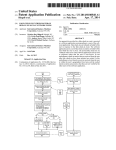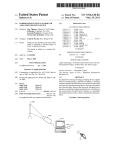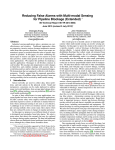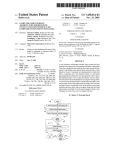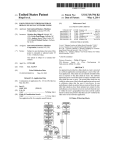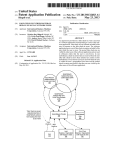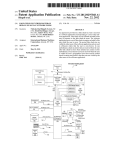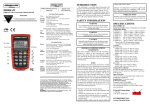Download Fake check-in entries posted on behalf of social network users
Transcript
USOO8707271B2
(12) Unlted States Patent
(10) Patent N0.:
Bingell et a].
(54)
(75)
(45) Date of Patent:
FAKE CHECK_IN ENTRIES POSTED ON
2009/0047972 A1
2010/0024042 A1
2/2009 Neeraj ..................... .. 455/456.1
1/2010 Motahari et a1.
726/26
2010/0077484 A1
3/2010
Inventors: Nicholas Dayl Bingell, Raleigh, NC
2011/0093340 Al
Paretti et al.
.......
. . . .. 726/26
400“ Kramer et al' """""" " 705/1458
OTHER PUBLICATIONS
(US); David Michael Stecher, Durham,
Li et al., “Sharing Location in Online Social Networks”, 2010*
Li et al., Analysis of a location-based social Network, 2009.*
He et al., “Location Cheating: A Security Challenge to Location
based SOClal NetWQTk servwesna Feb: 21’ 2011*
_
_
Scellato et al., “Distance Matters: Geo-s001al Metrics for Onl1ne
Assignee: International Business Machines
Corporation Armonk NY (Us)
Notice:
*
NC (US)
’
(*)
Apr. 22, 2014
BEHALF OF SOCIAL NETWORK USERS
(US); Erich Paul HOPPe, Raleigh, NC
(US); Andrew Ivory, Wake Forest, NC
(73)
US 8,707,271 B2
’
Social Networks”, 2010*
Subject to any disclaimer, the term of this
patent is extended or adjusted under 35
* .t d b
.
Cl 6 y exammer
U.S.C. 154(b) by 404 days.
(21)
(22) Filed:
Prior Publication Data
Us 2012/0297368 A1
(52)
(58)
Int_ CL
@061? 9/44
us CL
&
VanLeeuwen; Jeffrey S. LaBaW
May 20, 2011
(65)
(51)
Primary Examiner * Phillip H Nguyen
(74) Attorney, Agent, or Firm * VanLeeuwen
Appl. No.: 13/112,150
(57)
NOV_ 22’ 2012
ABSTRACT
An approach is provided in a fake check-in event is received
at a software application corresponding to a user of the soft
ware application. Fake check-ins are initiated on behalf of the
user in response to the fake check-in event. The software
applicationposts a set of fake check-in entries on behalf of the
(200601)
USPC ............................................. .. 717/126; 705/5
user while the user is away- The Posted fake check-ins are
Field of Classi?cation Search
visible by other users of the software application and are used
None
to obfuscate others that the user is out-of-town. In one
See application ?le for complete search history
(56)
References Cited
U.S. PATENT DOCUMENTS
7,856,360 B2*
2003/0093553 A1
2005/0050352 A1
12/2010
5/2003
embodiment, check-in entries that are received from the user
after fake check-ins have been initiated are cached. In this
embodiment, a local check-in event is received When the user
is Within the user’s geographical local area and the cached
check-in entries are posted so that they are now visible by the
other users of the software application.
Kramer et al. ............... .. 705/l.l
Le et al. ...................... .. 709/238
3/2005 Narayanaswamiet a1.
713/201
28 Claims, 8 Drawing Sheets
US. Patent
Apr. 22, 2014
Sheet 1 0f8
US 8,707,271 B2
F
inf?ramtiii?ggiing Sgstam
Beimarg
3 3’5 WW», Ram-9w? mm gas
<72?
Maw?
m
; . mmg,
r~
,a game
y.
£42 ,
3:25
Exgyessfjalrée
Exams-as
1.251%
M5
I
,
-
isetestiaae
3,
-
-,
Em?
$911222
$111112
’
“
mm;
5I
13,1 ,2;
$e§§§¥2
it??? "Mg
,
{‘mimiiar
W3
$216511
,
I
?smuairy
. '
1:
‘
US. Patent
Apr. 22, 2014
Sheet 2 0f8
$12,292,222?!
US 8,707,271 B2
fag-aw;
£32222 am
2 H25:
Hamiiing
., I amiss?»
'
-
FIG. 2
US. Patent
Apr. 22, 2014
,
Sheet 3 0f8
US 8,707,271 B2
$923552? ?ewark
Miiama ii’sai views
1,
“$8M
>
9mm:
memit-m
Swazi
mwmgwm '
m,
“x
3:
3
I
aim
(3 Evsiigmm
Susi:an
US. Patent
Apr. 22 , 2014
US 8,707,271 B2
Sheet 4 0f 8
fake swag-rm
m "
rsgia'émézm away;
@525.
i
533% Wigwam {mamm
M
shewin §9£Ms éi?iage
52m? mm :6 mar
4
User
time iéwmiwié far 31%;:
$835:
:1; swam;
iisar saw-5w?
wwéim wax as?
2%
L
i
Kiss?
Ra mm?
is
Y
4
*fake {lizazkén
swans; semi
M'Iwwwwm
US. Patent
Apr. 22, 2014
US 8,707,271 B2
Sheet 5 0f 8
AL
5,33
i
Mammi as! gutvmzatiat:
aim?
l
mm
am mi?es
we: 2%
that
is
v 38
istai
ac!
m
-'
.
l
amafs
.
4
.
A,
>
,5:
,,,,,
U
US. Patent
Apr. 22, 2014
Sheet 6 0f8
US 8,707,271 B2
business‘
at;
K
ma? mm mga
#:5452212.
$23.?
wing; aw s iami
W
Muw.
,?suiemaiiwéig:
Mm
v
_
kiwi eftewn M I
w mag?
man agar am;
xx
mm 25%
‘3"
2
Jw
w; 322%
a Fig,
‘ ' 5;
a“;
US. Patent
Apr. 22, 2014
Sheet 7 0f8
US 8,707,271 B2
mm
225:? 133%
Yas
i552?
'- .............. ..
.............. ..
1}
>
¢
"
ii
rm; -----'
w}
2%
{m
2322?
{229%}
i.
Y6?
,2
,,
is: ?gure srewrrw
3Q
3
w
,
w»
753328
US. Patent
Apr. 22, 2014
Sheet 8 0f8
US 8,707,271 B2
(mam
Lian <9 , Y -'
Mwwwis
ngg
swim,” »» 5%wa miwie? nawms
'
i
we
,
I
arssmriaas?
&
4,
{mm
'
“WM
US 8,707,271 B2
1
2
FAKE CHECK-IN ENTRIES POSTED ON
BEHALF OF SOCIAL NETWORK USERS
BRIEF DESCRIPTION OF THE SEVERAL
VIEWS OF THE DRAWINGS
BACKGROUND
The present invention may be better understood, and its
numerous objects, features, and advantages made apparent to
those skilled in the art by referencing the accompanying
The present invention relates to an approach that provides
virtual location check-in entries at a social network provider
drawings, wherein:
using both fake check in entries and caching of check in
FIG. 1 is a block diagram of a data processing system in
which the methods described herein can be implemented;
FIG. 2 provides an extension of the information handling
system environment shown in FIG. 1 to illustrate that the
methods described herein can be performed on a wide variety
of information handling systems which operate in a net
entries while the user is out of town.
Many social media sites allow users to post their physical
location that appears in various pages on the social media site,
such as the user’s page and the page corresponding to a
business or organization at which the user checked in. Users
worked environment;
choose to check into a business for a variety of reasons. These
FIG. 3 is a diagram showing various social media partici
reasons include keeping the user’s social media “friends”
apprised of their whereabouts, increasing the chance of meet
ing friends at a particular business, and supporting various
business by indicating that the user has visited the business.
Modern computer networking, such as using the Internet,
pants and how fake check-ins are used to prevent malevolent
members of the social media community from knowing when
a particular user is out of town;
FIG. 4 is a ?owchart showing registration steps used by a
20
coupled with modern travel technologies allows users to
check in at businesses in various geographic areas, such as
different places in a country or throughout the world.
BRIEF SUMMARY
social media provider to notify when the user is out-of-town
and the transmission and reception of check-ins;
25
An approach is provided in a fake check-in event is
received at a software application corresponding to a user of
the software application. Fake check-ins are initiated on
behalf of the user in response to the fake check-in event. The
software application posts a set of fake check-in entries on
behalf of the user while the user is away. The posted fake
FIG. 6 is a ?owchart showing the steps used at the social
media provider to handle check-ins received from users;
FIG. 7 is a ?owchart showing the steps used at the social
media provider to perform fake check-ins on behalf of a user
that is out-of-town; and
30
FIG. 8 is a ?owchart showing the steps taken at the social
media provider to reverse the effects of fake check-ins when
the user is no longer out-of-town.
DETAILED DESCRIPTION
check-ins are visible by other users of the software applica
tion and are used to obfuscate others that the user is out-of
town. In one embodiment, check-in entries that are received
from the user after fake check-ins have been initiated are
cached. In this embodiment, a local check-in event is received
when the user is within the user’s geographical local area and
the cached check-in entries are posted so that they are now
user to set up fake check-ins at a social media provider;
FIG. 5 is a ?owchart showing steps between a user and the
35
The terminology used herein is for the purpose of describ
ing particular embodiments only and is not intended to be
limiting of the invention. As used herein, the singular forms
“a”, “an” and “the” are intended to include the plural forms as
40
well, unless the context clearly indicates otherwise. It will be
further understood that the terms “comprises” and/or “com
visible by the other users of the software application
prising,” when used in this speci?cation, specify the presence
In a further embodiment, the set of fake check-ins that were
posted while the user was away are removed when the user
returns so that they are no longer visible to other users of the
of stated features, integers, steps, operations, elements, and/
application. Additionally, the fake check-ins that are posted
45
or components, but do not preclude the presence or addition
of one or more other features, integers, steps, operations,
elements, components, and/ or groups thereof.
The corresponding structures, materials, acts, and equiva
are, in one embodiment, gathered from the user’ s prior check
in history and are posted at appropriate times and days of the
lents of all means or step plus function elements in the claims
week in order to more fully obfuscate others that the user is
out-of-town. In one embodiment, the indicator that the user is
out of town is set manually by the user using a control pro
below are intended to include any structure, material, or act
50
vided by the application. In this embodiment, the second
indicator indicating that the user has returned home can also
for performing the function in combination with other
claimed elements as speci?cally claimed. The description of
the present invention has been presented for purposes of
illustration and description, but is not intended to be exhaus
tive or limited to the invention in the form disclosed. Many
modi?cations and variations will be apparent to those of
be set manually. In another embodiment, the indicator that the
user is out of town is set by receiving a check in entry from the
user at an entity, such as a business or organization, that is 55 ordinary skill in the art without departing from the scope and
outside of the user’s geographic local area. In this embodi
ment, the second indicator that indicates that the user has
returned home can be set by the user checking into an entity
that is within the user’s geographic local area.
The foregoing is a summary and thus contains, by neces
spirit of the invention. The embodiment was chosen and
described in order to best explain the principles of the inven
tion and the practical application, and to enable others of
ordinary skill in the art to understand the invention for various
60
sity, simpli?cations, generalizations, and omissions of detail;
embodiments with various modi?cations as are suited to the
consequently, those skilled in the art will appreciate that the
particular use contemplated.
As will be appreciated by one skilled in the art, aspects of
summary is illustrative only and is not intended to be in any
the present invention may be embodied as a system, method
way limiting. Other aspects, inventive features, and advan
tages of the present invention, as de?ned solely by the claims,
will become apparent in the non-limiting detailed description
set forth below.
or computer program product. Accordingly, aspects of the
65
present invention may take the form of an entirely hardware
embodiment, an entirely software embodiment (including
?rmware, resident software, micro-code, etc.) or an embodi
US 8,707,271 B2
3
4
ment combining software and hardware aspects that may all
programmable data processing apparatus to produce a
machine, such that the instructions, which execute via the
generally be referred to herein as a “circuit,” “module” or
“system.” Furthermore, aspects of the present invention may
take the form of a computer program product embodied in one
processor of the computer or other programmable data pro
cessing apparatus, create means for implementing the func
or more computer readable medium(s) having computer read
able program code embodied thereon.
block or blocks.
tions/acts speci?ed in the ?owchart and/or block diagram
These computer program instructions may also be stored in
Any combination of one or more computer readable medi
um(s) may be utilized. The computer readable medium may
a computer readable medium that can direct a computer, other
be a computer readable signal medium or a computer read
programmable data processing apparatus, or other devices to
function in a particular manner, such that the instructions
stored in the computer readable medium produce an article of
able storage medium. A computer readable storage medium
may be, for example, but not limited to, an electronic, mag
system, apparatus, or device, or any suitable combination of
manufacture including instructions which implement the
function/act speci?ed in the ?owchart and/or block diagram
the foregoing. More speci?c examples (a non-exhaustive list)
block or blocks.
of the computer readable storage medium would include the
The computer program instructions may also be loaded
onto a computer, other programmable data processing appa
netic, optical, electromagnetic, infrared, or semiconductor
following: an electrical connection having one or more wires,
a portable computer diskette, a hard disk, a random access
ratus, or other devices to cause a series of operational steps to
memory (RAM), a read-only memory (ROM), an erasable
be performed on the computer, other programmable appara
programmable read-only memory (EPROM or Flash
memory), an optical ?ber, a portable compact disc read-only
memory (CD-ROM), an optical storage device, a magnetic
tus or other devices to produce a computer implemented
20
process such that the instructions which execute on the com
puter or other programmable apparatus provide processes for
implementing the functions/acts speci?ed in the ?owchart
storage device, or any suitable combination of the foregoing.
In the context of this document, a computer readable storage
and/or block diagram block or blocks.
The following detailed description will generally follow
medium may be any tangible medium that can contain, or
store a program for use by or in connection with an instruction 25 the summary of the invention, as set forth above, further
execution system, apparatus, or device.
A computer readable signal medium may include a propa
explaining and expanding the de?nitions of the various
gated data signal with computer readable program code
this end, this detailed description ?rst sets forth a computing
environment in FIG. 1 that is suitable to implement the soft
ware and/or hardware techniques associated with the inven
embodied therein, for example, in baseband or as part of a
carrier wave. Such a propagated signal may take any of a
aspects and embodiments of the invention as necessary. To
30
variety of forms, including, but not limited to, electro-mag
tion. A networked environment is illustrated in FIG. 2 as an
netic, optical, or any suitable combination thereof. A com
puter readable signal medium may be any computer readable
medium that is not a computer readable storage medium and
that modern computing techniques can be performed across
that can communicate, propagate, or transport a program for
use by or in connection with an instruction execution system,
apparatus, or device.
Program code embodied on a computer readable medium
may be transmitted using any appropriate medium, including
but not limited to wireless, wireline, optical ?ber cable, RF,
extension of the basic computing environment, to emphasize
35
mation handling system 100 includes one or more processors
40
etc., or any suitable combination of the foregoing.
Computer program code for carrying out operations for
aspects of the present invention may be written in any com
bination of one or more programming languages, including
an object oriented programming language such as Java,
Smalltalk, C++ or the like and conventional procedural pro
multiple discrete devices.
FIG. 1 illustrates information handling system 100, which
is a simpli?ed example of a computer system capable of
performing the computing operations described herein. Infor
110 coupled to processor interface bus 112. Processor inter
face bus 112 connects processors 110 to Northbridge 115,
which is also known as the Memory Controller Hub (MCH).
Northbridge 115 connects to system memory 120 and pro
vides a means for processor(s) 110 to access the system
45
memory. Graphics controller 125 also connects to North
bridge 115. In one embodiment, PCI Express bus 118 con
nects Northbridge 115 to graphics controller 125. Graphics
gramming languages, such as the “C” programming language
controller 125 connects to display device 130, such as a
or similar programming languages. The program code may
execute entirely on the user’s computer, partly on the user’s
computer monitor.
Northbridge 115 and Southbridge 135 connect to each
computer, as a stand-alone software package, partly on the
user’s computer and partly on a remote computer or entirely
on the remote computer or server. In the latter scenario, the
remote computer may be connected to the user’s computer
50
other using bus 119. In one embodiment, the bus is a Direct
55
Media Interface (DMI) bus that transfers data at high speeds
in each direction between Northbridge 115 and Southbridge
135. In another embodiment, a Peripheral Component Inter
connect (PCI) bus connects the Northbridge and the South
bridge. Southbridge 135, also known as the I/O Controller
through any type of network, including a local area network
(LAN) or a wide area network (WAN), or the connection may
Hub (ICH) is a chip that generally implements capabilities
that operate at slower speeds than the capabilities provided by
the Northbridge. Southbridge 135 typically provides various
be made to an external computer (for example, through the
Internet using an Internet Service Provider).
Aspects of the present invention are described below with
reference to ?owchart illustrations and/ or block diagrams of
methods, apparatus (systems) and computer program prod
busses used to connect various components. These busses
60
ucts according to embodiments of the invention. It will be
understood that each block of the ?owchart illustrations and/
or block diagrams, and combinations of blocks in the ?ow
chart illustrations and/or block diagrams, can be imple
mented by computer program instructions. These computer
program instructions may be provided to a processor of a
general purpose computer, special purpose computer, or other
65
include, for example, PCI and PCI Express busses, an ISA
bus, a System Management Bus (SMBus or SMB), and/or a
Low Pin Count (LPC) bus. The LPC bus often connects
low-bandwidth devices, such as boot ROM 196 and “legacy”
I/O devices (using a “super I/O” chip). The “legacy” I/O
devices (198) can include, for example, serial and parallel
ports, keyboard, mouse, and/or a ?oppy disk controller. The
LPC bus also connects Southbridge 135 to Trusted Platform
US 8,707,271 B2
5
6
Module (TPM) 195. Other components often included in
Southbridge 135 include a Direct Memory Access (DMA)
controller, a Programmable Interrupt Controller (PIC), and a
storage device controller, which connects Southbridge 135 to
methods described herein can be performed on a wide variety
of information handling systems that operate in a networked
environment. Types of information handling systems range
nonvolatile storage device 185, such as a hard disk drive,
from small handheld devices, such as handheld computer/
mobile telephone 210 to large mainframe systems, such as
using bus 184.
mainframe computer 270. Examples of handheld computer
210 include personal digital assistants (PDAs), personal
ExpressCard 155 is a slot that connects hot-pluggable
devices to the information handling system. ExpressCard 155
entertainment devices, such as MP3 players, portable televi
supports both PCI Express and USB connectivity as it con
nects to Southbridge 135 using both the Universal Serial Bus
sions, and compact disc players. Other examples of informa
tion handling systems include pen, or tablet, computer 220,
(USB) the PCI Express bus. Southbridge 135 includes USB
Controller 140 that provides USB connectivity to devices that
connect to the USB. These devices include webcam (camera)
laptop, or notebook, computer 230, workstation 240, personal
computer system 250, and server 260. Other types of infor
mation handling systems that are not individually shown in
FIG. 2 are represented by information handling system 280.
As shown, the various information handling systems can be
150, infrared (IR) receiver 148, keyboard and trackpad 144,
and Bluetooth device 146, which provides for wireless per
networked together using computer network 200. Types of
sonal area networks (PANs). USB Controller 140 also pro
vides USB connectivity to other miscellaneous USB con
nected devices 142, such as a mouse, removable nonvolatile
storage device 145, modems, network cards, ISDN connec
tors, fax, printers, USB hubs, and many other types of USB
connected devices. While removable nonvolatile storage
computer network that can be used to interconnect the various
20
device 145 is shown as a USB-connected device, removable
nonvolatile storage device 145 could be connected using a
tile data stores, such as hard drives and/or nonvolatile
different interface, such as a Firewire interface, etcetera.
Wireless Local Area Network (LAN) device 175 connects
to Southbridge 135 via the PCI or PCI Express bus 172. LAN
device 175 typically implements one of the IEEE 802.11
standards of over-the-air modulation techniques that all use
the same protocol to wireless communicate between infor
mation handling system 100 and another computer system or
device. Optical storage device 190 connects to Southbridge
25
memory. Some of the information handling systems shown in
FIG. 2 depicts separate nonvolatile data stores (server 260
utilizes nonvolatile data store 265, mainframe computer 270
utilizes nonvolatile data store 275, and information handling
system 280 utilizes nonvolatile data store 285). The nonvola
30
tile data store can be a component that is external to the
various information handling systems or can be internal to
135 using Serial ATA (SATA) bus 188. Serial ATA adapters
one of the information handling systems. In addition, remov
and devices communicate over a high-speed serial link. The
Serial ATA bus also connects Southbridge 135 to other forms
of storage devices, such as hard disk drives. Audio circuitry
information handling systems include Local Area Networks
(LANs), Wireless Local Area Networks (WLANs), the Inter
net, the Public Switched Telephone Network (PSTN), other
wireless networks, and any other network topology that can
be used to interconnect the information handling systems.
Many of the information handling systems include nonvola
able nonvolatile storage device 145 can be shared among two
35
or more information handling systems using various tech
niques, such as connecting the removable nonvolatile storage
160, such as a sound card, connects to Southbridge 135 via
device 145 to a USB port or other connector of the informa
bus 158. Audio circuitry 160 also provides functionality such
as audio line-in and optical digital audio in port 162, optical
tion handling systems.
digital output and headphone jack 164, internal speakers 166,
pants and how fake check-ins are used to prevent malevolent
and internal microphone 168. Ethernet controller 170 con
nects to Southbridge 135 using a bus, such as the PCI or PCI
FIG. 3 is a diagram showing various social media partici
40
a particular user is out of town. Social network provider 300
provides facilities, such as a Web site that uses a computer
Express bus. Ethernet controller 170 connects information
handling system 100 to a computer network, such as a Local
network (e.g., computer network 200 shown in FIG. 2), that
Area Network (LAN), the Internet, and other public and
private computer networks.
45
While FIG. 1 shows one information handling system, an
information handling system may take many forms. For
example, an information handling system may take the form
of a desktop, server, portable, laptop, notebook, or other form
factor computer or data processing system. In addition, an
information handling system may take other form factors
such as a personal digital assistant (PDA), a gaming device,
ATM machine, a portable telephone device, a communication
data store 305. Social network data can pertain to individual
users (e.g., “friends,” “colleagues,” etc.) as well as to entities
50
(e.g., businesses, organizations, clubs, etc.).
Mobile computing devices, such as smart phones and the
like, can be utilized to “check in” to an entity, such as a
business or organization. When a user checks into an entity, a
55
check-in entry is received at the software application, such as
at the social network provider’s Web site. When a user checks
into an entity, the software application posts the check-in on
the user’s social network page and also at the entities social
network page. However, as explained herein, a fake check-in
60
event, such as a check-in at an entity outside of the user’s
geographic local area, causes the user’s check-in entries to be
cached rather than immediately posted to the user’s social
network page and the entity’s social network page. When the
cation Version 1.2.” The TPM is a hardware security sub
system that may be incorporated into any number of
information handling systems, such as those outlined in FIG.
2.
FIG. 2 provides an extension of the information handling
system environment shown in FIG. 1 to illustrate that the
allows users to communicate, often informally, with one
another. Users include individual users of social network
provider 300, such as user 310, that access social networking
data, stored by the social network provider, in social network
device or other devices that include a processor and memory.
The Trusted Platform Module (TPM 195) shown in FIG. 1
and described herein to provide security functions is but one
example of a hardware security module (HSM). Therefore,
the TPM described and claimed herein includes any type of
HSM including, but not limited to, hardware security devices
that conform to the Trusted Computing Groups (TCG) stan
dard, and entitled “Trusted Platform Module (TPM) Speci?
members of the social media community from knowing when
user returns to their local area, or otherwise triggers a local
65
check-in event, the cached entries are posted to the user’s
social network page as well as to the entity’s social network
page. While the user is away, fake check-in entries are posted
by the social network software application with these fake
US 8,707,271 B2
7
8
check-in entries being visible to other users of the social
user registers with the social network Web site (software
application) for a fake check-in service that is offered by the
social network provider. In addition, the user provides a geo
graphic local area (e.g., town name, zip or postal code, GPS
network provider. These fake check-in entries are posted
while the user is out of town in order to obfuscate other users
of social network provider 300 from knowing that the user is
away from home (and thus vulnerable to having the user’s
coordinates, etc.) that correspond to the user. Registration
home and/ or property burglarized and/ or stolen while the user
is away). Other users may be members of one or more differ
ent social network audiences. In another embodiment, a fake
request 410 is transmitted via a computer network, such as the
Internet, after which it is received by the social network
provider. Social network provider’s processing commences
at 420 whereupon, at step 425, the social network provider
check-in event is received when a certain time period elapses
after the user’s last check-in event. For example, if the user
checks into a business entity, such as a gym, but is injured and
taken to a hospital so that an extended period of time elapses
(e. g., a day, etc.) since the user’s last check-in entry, then the
system will automatically initiate fake check-ins to obfuscate
the fact that the user is indisposed (e.g., at the hospital, etc.)
and is not at home. Audience 350 are associated directly with
user 310, such as by being linked to the user through an online
friendship or linking process that veri?es that the user wishes
receives the fake check-in request that was prepared and sent
by the user. At step 430, the fake check-in registration is saved
in social network data store 305 in a private area, such as a
user pro?le area, that is not accessible by other users of the
social network provider. In addition, fake check-in options, as
offered by the social network provider, are prepared and
transmitted back to the user as Web page 435.
At step 440, the user receives and displays the fake check
in options dialog (e. g., a Web page, etc.) that was transmitted
from the social network provider. At step 445, the user selects
to allow members of audience 350 with access to user 310’s
social network data.
By utilizing network facilities, such as the Internet, users
can check-in at entities in various geographic locations
throughout the world. In this manner, entities can be physi
cally within a geographic local area that corresponds to a
particular user (e.g., user 310), and can also be physically
outside of the geographic local area that corresponds to the
user. For example, if the user’s geographic local area (e.g.,
20
25
fake check-in processing will be initiated for the user by the
social network provider. Automatic fake check-in is a process
whereby the social network provider analyzes the user’s
check-in entries and automatically initiates the fake check-in
processing when the social network provider senses that the
user is outside of the user’s geographic local area (e.g., when
home) is in Raleigh, NC, then entities in geographic prox
imity Raleigh would be deemed within the user’ s geographic
local area. When a user checks in at a Raleigh-area entity,
such as a gym located in Raleigh, then a check-in entry is
whether manual or automatic fake check-in initiation is pre
ferred by the user. Manual fake check-in is a process whereby
the user informs the social network provider when the user is
traveling outside of the user’s geographic local area so that
30
a check-in entry is received from the user at an entity that is
outside the user’s geographic local area, etc.).At step 448, the
posted on the user’s social network page as well as the local
user selects a time threshold to use to initiate an automatic
entities social network page (e.g., local entity 320). This
fake check-in event. For example, if the user selects “two
check-in entry is visible by other users that are members of
audience 350 (e.g., friends of user 310) as well by other users
35
days” in step 448, then if a check-in entry is not received from
the user within two days, the system automatically triggers a
that are members of audience 360 (e.g., customers, employ
ees, supporters, etc. of the Raleigh-area gym).
fake check-in event so that fake check-ins are posted on
behalf of the user to obfuscate the fact that the user is indis
When user 310 travels out of town away from the Raleigh
area, then the actual check-in entries received from the user
are cached rather than posted and fake check-in entries are
posted to obfuscate the fact that the user is out of town. For
example, if the user travels to Austin, Tex. and checks in at an
posed or otherwise away and unable to perform check-in
Austin-area gym, then social network provider 300 would
receive the check-in entry corresponding to the Austin-area
gym. Instead of posting the check-in entry at the user’s social
network page and the out-of-town social network page (e.g.,
social network page 330), the system caches the received
check-in entry and waits until the user has returned home (to
40
the fake check-in entries. For example, the user can select a
“typical” week of actual check-ins from the user’ s history that
45
will be used as fake check-in entries when the user is out of
town. Alternatively, the user can manually select the fake
check-in entries (e.g., entity name, time of day, day of week,
etc.) that the user wants to use for the user’s fake check-in
entries. If the user does not provide a typical week or select
Raleigh) before posting the check-in entries. In addition,
malevolent users of the social network provider may other
wise realize that the user is not checking into local Raleigh
area entities where the user typically frequents. Fake check-in
entries are posted at local entities (e. g., the Raleigh-area gym,
etc.) so that it appears as though the user is still in the Raleigh
area. When the user returns from the trip and is back in the
Raleigh area, the cached check-in entries are posted to the
entries (e.g., at the hospital, without network access, etc.). At
step 450, the user optionally selects a preferred fake check-in
option that is used by the social network provider in selecting
50
the fake check-in entries, then the social network provider can
utilize an algorithm where appropriate entities are selected
(e.g., based on the user’s past check-in history, etc.), along
with appropriate days of the week and time of day when the
fake check-in entries will be posted.
A decision is made as to whether the user selected to use a
55
typical week of check-in entries from the user’s history (deci
sion 460). If the user opted to use a typical week, then deci
user’s social network page as well as to the out of town
sion 460 branches to the “yes” branch whereupon, at step 465,
entities pages (e.g., the Austin-area gym, etc.) where the user
actually checked in while on the trip to Austin. In addition, in
the user selects a previous week of check-in entries to use as
one embodiment, once the user returns home, the fake check
in entries that were posted while the user was out of town are
removed from both the user’s social network page as well as
60
the user did not opt to use a typical week, then decision 460
branches to the “no” branch whereupon a decision is made as
from the local area entity pages (e. g., from the Raleigh-area
gym, etc.).
FIG. 4 is a ?owchart showing registration steps used by a
user to set up fake check-ins at a social media provider. User
processing commences at 400 whereupon, at step 405, the
fake check-in entries (copying the entity, approximate check
in time, and check-in day of the week). On the other hand, if
65
to whether the user opted to manually select the fake check-in
entries to use (decision 470). If the user opted to manually
select the fake check-in entries, then decision 470 branches to
the “yes” branch whereupon, at step 475, the user manually
selects the fake check-in entries (the entities, approximate
US 8,707,271 B2
10
processing details). On the other hand, if fake check-ins have
check-in times, and check-in days of the week) to use as fake
check-in entries. On the other hand, if the user did not select
either a typical week or manual fake check-in entries, then
decision 470 branches to the “no” branch whereupon, at step
480, the social network application will use an algorithm to
randomly select fake check-in entries that are used based on
not been initiated, then decision 570 branches to the “no”
branch which loops back to step 565 to get the next noti?ca
tion from either the social network provider (system 300) or
from the user.
After fake check-ins have been initiated and prede?ned
the user’s past check-in history.
process 575 has been executed, a decision is made as to
At step 485, the user’s fake check-in options are transmit
ted to the social network application via the computer net
work as options transmittal 490. At step 495, the social net
whether fake check-ins have been terminated, either manu
ally or automatically, for the user (decision 580). If fake
check-in processing has not been terminated (e. g., the user is
still out of town, etc.), then decision 580 branches to the “yes”
branch which loops back to continue fake check-in process
work application receives the user’s fake check-in options
and saves the options in a private area included in social
network data store 305.
FIG. 5 is a ?owchart showing steps between a user and the
ing using prede?ned process 575. This looping continues
until fake check-ins have been terminated, at which point
decision 580 branches to the “yes” branch whereupon, at
social media provider to notify when the user is out-of-town
and the transmission and reception of check-ins. Processing
prede?ned process 585, fake check-in reversal processing is
executed (see FIG. 8 and corresponding text for processing
commences at 500 whereupon, at step 505, the user is travel
ing outside of the user’s geographic local area. A decision is
details). After fake check-in reversal process 585 has been
performed, processing loops back to step 565 to receive the
made as to whether manual or automatic fake check-in ini
tiation is being used (decision 510). If automatic fake check
20
in initiation is being used, then decision 510 branches to the
branch labeled “automatic” whereupon, at step 515, the social
network provider’ s application software automatically senses
when the user is outside of the user’s geographic local area
(e.g., when a check-in entry is received from the user at an
entity that is outside of the user’ s geographic local area, etc.).
On the other hand, if manual fake check-in initiation is being
used, then decision 510 branches to the branch labeled
“manual” whereupon, at step 520, the user noti?es the social
network provider that the user is traveling outside of the
The social network provider’ s high level check-in process
is shown commencing at 590 whereupon, at step 592, the
social network provider receives check-in entries from the
user at various entities (both within and outside of the user’s
25
initiate an automatic fake check-in event when a given time
30
that are outside the user’ s geographic local area. These check
in actions result in check-in entries being transmitted to the
expires (decision 598). If the next check-in is received from
35
the user returns home to the user’s geographic local area. A
decision is made as to whether manual or automatic fake
the user exceeds the threshold, then decision 598 branches to
40
step 540, the social network provider’s application software
45
will automatically initiate the fake check-in processing as
described herein.
Social network provider check-in processing continues to
loop back to receive further check-in entries from the user and
continues to process the check-in entries using prede?ned
50
process 596.
FIG. 6 is a ?owchart showing the steps used at the social
media provider to handle check-ins received from users.
Check-in processing commences at 600 whereupon, at step
605, a check-in entry (request) is received from the user at a
55
physical entity location (e. g., a gym, a grocery store, etc.). At
geographic local area. These local check-ins continue until
the user once again travels outside of the user’s geographic
local area, at which point processing loops back to step 505
and the process described above is repeated.
Fake check-in initiation processing that is performed by the
the “threshold exceeded” branch which triggers the fake
check-in event and initiates fake-check in processing on
behalf of the user. For example, the user could set the thresh
old to be “two days” so that if a new check-in entry is not
received from the user in a two day period, then the system
automatically senses when the user has returned to the user’ s
performs check-in at various entities that are within the user’ s
the user, then decision 598 branches to “next check-in”
branch which loops back to process the latest check in as
described above and resets the timestamp. On the other hand,
if the amount of time since the last check-in was received by
check-in initiation is being used (decision 535). If automatic
fake check-in initiation is being used, then decision 535
geographic local area (e.g., when a check-in entry is received
from the user at an entity that is within the user’s geographic
local area, etc.). On the other hand, if manual fake check-in
initiation is being used, then decision 535 branches to the
branch labeled “manual” whereupon, at step 545, the user
noti?es the social network provider that the user has returned
to the user’s geographic local area. At step 550, the user
the user’s last check-in was received. In this embodiment, at
step 596, the latest (last) check-in entry received from the user
is timestamped. A decision is made as to whether the user’s
next check-in request arrives before the time threshold
At step 525, the user performs check-in actions at entities
branches to the branch labeled “automatic” whereupon, at
geographic local area). Prede?ned process 594 handles the
various check-in entries (see FIG. 6 and corresponding text
for processing details). In one embodiment, the system can
period (e.g., a time threshold set by the user, etc.) elapses after
user’s geographic local area.
social network provider. At some point, indicated by step 530,
next manual or automatic noti?cation.
social network provider commences at 560 whereupon, at
step 610, the user’s private pro?le that is not accessible by
step 565, the social network provider either receives events
other users of the social network provider is retrieved and, at
step 615, a business pro?le corresponding to the entity at
from both the user and the system. These events can include
fake check-in events that are triggered manually by the user or
automatically triggered events initiated from the check-in
60
subsystem of the social network application (system 300). A
decision is made as to whether fake check-ins (manual or
automatic) have been initiated for the user (decision 570). If
fake check-ins have been initiated, then decision 570
branches to the “yes” branch whereupon, at prede?ned pro
cess 575, the social network provider’s fake check-in process
is executed for the user (see FIG. 7 and corresponding text for
which the user checked in is retrieved. Using data found in the
pro?les, the location of the entity is compared with the user’ s
geographic local area at step 620. A decision is made as to
whether the entity is within the user’s geographic local area
(decision 625). If the entity is within the user’s geographic
65
local area, then decision 625 branches to the “yes” branch
whereupon an “away” ?ag is set to FALSE indicating that the
user is not outside of the user’s geographic local area. On the
other hand, if the entity is outside of the user’s geographic
US 8,707,271 B2
11
12
local area, then decision 625 branches to the “no” branch
whereupon, the “away” ?ag is set to TRUE indicating that the
selected entity names are retrieved along with the time of day
and day of week to use for the fake check-in entries. On the
user is outside of the user’s geographic local area. A decision
is made as to whether fake check-ins have been initiated
chosen by the user, then decision 720 branches to the “no”
indicating that the user is out of town (decision 640). If fake
check-ins have been initiated, then decision 640 branches to
the “yes” branch whereupon a decision is made as to whether
branch whereupon, at step 730, the social network provider
automatically retrieves random local entity check-in entries
along with the time of day and day of week from the user’s
the user has requested to automatically sense when the user is
within or outside of the user’s geographic local area AND if
history of past actual check-in entries to local entities.
At step 740, the list of fake check-in entries is queued to
fake check-ins queue 750. Fake check-ins queue 750 includes
?elds for the day of the week, the time of day, and the entity
other hand, if neither a typical week or a user selected list was
the “away” ?ag is FALSE (decision 645). If both conditions
are true (the user has requested automatic sensing of the
user’s in-town/out-of-town status and the and the check-in
performed by the user is to a local entity), then decision 645
branches to the “yes” branch whereupon, at step 650, an event
name or identi?er. At step 760, the fake check-ins process
sleeps until the ?rst day of the week and time of day occurs as
listed in fake check-in queue 750. When the ?rst day of week
is sent to the social network provider (see FIG. 5, step 565) to
stop, or terminate, fake check-in processing. On the other
hand, if either the user has requested manual initiation of fake
and time of day occurs, then a decision is made as to whether
fake check-in processing is still being performed for the user
(decision 765). If fake check-in processing is still being per
check-in processing OR the user is still outside of the user’s
geographic local area, then decision 645 branches to the “no”
branch bypassing step 650.
Returning to decision 640, if fake check-in processing has
20
entry corresponding to the day of week and time of day is
retrieved from fake check-ins queue 750. At step 775, the
retrieved fake check-in entry is posted to the user’s social
not been initiated, then decision 640 branches to the “no”
branch whereupon a decision is made as to whether the user
has requested to automatically sense when the user is within
or outside of the user’s geographic local area AND if the
network page 690 as well as to the entity’s social network
25
“away” ?ag is TRUE (decision 660). If both conditions are
true (the user has requested automatic sensing of the user’s
in-town/out-of-town status and the check-inperformed by the
social network provider. Processing then loops back to step
760 whereupon processing sleeps until the next day of week
30
the social network provider (see FIG. 5, step 565) to start, or
initiate, fake check-in processing. On the other hand, if either
the user has requested manual initiation of fake check-in
processing OR the user is within of the user’s geographic
local area, then decision 660 branches to the “no” branch
35
bypassing step 665.
rently being used for the user (decision 670). If fake check-ins
actual check-in to the out of town entity is queued to user’s
check-in cache 680 instead of posting the check-in to either
the user’s social network page or to the entity’s social net
work page. On the other hand, if fake check-ins are not
currently being used for the user, then decision 670 branches
to the “no” branch whereupon, at step 685, the actual check-in
entries are posted to both the user’s social network page 690
40
that is out-of-town. The social network provider’ s fake check
in processing commences at 700 whereupon, at step 705, the
social network provider retrieves the user’s fake check-in
con?guration settings. A decision is made as to whether the
user has opted to use a typical week of actual check-in entries
as fake check-in entries (decision 710). If a typical week is
45
50
and process the next fake check-in entry from fake check-ins
fake check-in entries that need to be reversed, at which point
decision 840 branches to the “no” branch for further reversal
55
processing.
At step 850, the ?rst check-in to an out-of-town entity that
was cached in user’s check-in cache 680 is selected. At step
860, the selected entry is posted to the user’s social network
page 690. At step 870, the selected entry is also posted to the
60
check-in entries. On the other hand, if the user did not opt to
use a typical week of check-in entries, then decision 710
branches to the “no” branch whereupon a decision is made as
entity’s social network page 695. A decision is made as to
whether there are more cached check-in entries that need to be
processed (decision 880). If there are more cached check-in
entries to process, then decision 880 branches to the “yes”
branch which loops back to select the next check-in entry that
to whether the user has opted to use a user selected set of fake
branches to the “yes” branch whereupon, at step 725, the user
the “yes” branch whereupon processing loops back to select
data store 785. This looping continues until there are no more
whereupon, at step 715, the entities (businesses, organiza
check-in entries (decision 720). If the user has opted to use a
user selected set of fake check-in entries, then decision 720
820, the selected fake check-in is removed (deleted) from the
user’s social network page 690 and, at step 830, the selected
fake check-in is removed (deleted) from the entity’s social
network page 695. A decision is made as to whether there are
more fake check-in entries stored in fake check-ins data store
785 that need to be reversed (decision 840). If there are more
fake check-in entries to reverse, then decision 840 branches to
being used, then decision 710 branches to the “yes” branch
tions, etc.) from the user’s selected week are retrieved along
with the time of day and day of week to use for the fake
er’s fake check-in reversal process commences at 800 where
upon, at step 810, the ?rst recorded fake check-in that was
recorded in fake check-ins data store 785 is selected. At step
as well as to the entity’s social network page 695.
FIG. 7 is a ?owchart showing the steps used at the social
media provider to perform fake check-ins on behalf of a user
and time of day in the fake check-ins queue is reached. When
the next day of week and time of day is reached, the process
ing as described above is performed. Fake check-in entries
continue to be posted until fake check-in processing is termi
nated, at which point decision 765 branches to the “no”
branch and fake check-in processing ends at 795.
FIG. 8 is a ?owchart showing the steps taken at the social
media provider to reverse the effects of fake check-ins when
the user is no longer out-of-town. The social network provid
A decision is made as to whether fake check-ins are cur
are currently being used for the user, then decision 670
branches to the “yes” branch whereupon, at step 675, the
page 695. At step 780, the fake check-in is recorded in fake
check-in data store 785 where fake check-in data store 785 is
an internal data store that is inaccessible from users of the
user is to an out of town entity), then decision 660 branches to
the “yes” branch whereupon, at step 665, an event is sent to
formed (the user has not returned home yet), then decision
765 branches to the “yes” branch whereupon, at step 770, the
65
was cached in user’s check-in cache 680 and the selected
entry is posted to the user’s and the entity’s social network
pages as described above. This looping continues until there
US 8,707,271 B2
14
13
4. The information handling system of claim 3 wherein at
are no more cached check-in entries to process, at which point
decision 880 branches to the “no” branch and processing ends
least one of the processors perform additional actions com
at 895.
prising:
While particular embodiments of the present disclosure
have been shown and described, it will be obvious to those 5
skilled in the art that, based upon the teachings herein, that
changes and modi?cations may be made without departing
from this disclosure and its broader aspects. Therefore, the
that the user has returned to the geographic local area
that corresponds to the user; and
in response to receiving the local check-in event, posting
the cached current check-in entries, wherein the posted
appended claims are to encompass within their scope all such
changes and modi?cations as are within the true spirit and
scope of this disclosure. Furthermore, it is to be understood
current check-in entries are visible by the other users of
that the disclosure is solely de?ned by the appended claims. It
the social network application.
will be understood by those with skill in the art that if a
speci?c number of an introduced claim element is intended,
such intent will be explicitly recited in the claim, and in the
5. The information handling system of claim 4 wherein at
15
absence of such recitation no such limitation is present. For
non-limiting example, as an aid to understanding, the follow
one” and inde?nite articles such as “a” or “an”; the same
holds true for the use in the claims of de?nite articles.
fake check-in entries are used to obfuscate the other users of
the social network application as to an out-of-town status of
the user while the user is physically outside of the geographic
local area that corresponds to the user.
7. The information handling system of claim 1 wherein the
by the social network application, and wherein the ?ags of the
1. An information handling system comprising:
fake check-ins are not visible by the other users of the social
0 network application.
8. The information handling system of claim 1 wherein at
least one of the processors perform additional actions com
prising:
selecting the set of fake check-in entries from a plurality of
previous actual check-in entries corresponding to the
user, wherein each of the plurality of previous actual
check-in entries were check-ins to one or more entities
40
that are physically within the geographic local area cor
responding to the user.
9. The information handling system of claim 8 wherein at
the social network application; and
least one of the processors perform additional actions com
initiating fake check-ins on behalf of the user in response to
prising:
receiving the fake check-in event, wherein initiating the
fake check-ins further comprises:
receiving one or more current check-in entries from the 45
identifying the set of fake check-in entries from a nonvola
tile storage area accessible from the social network
application;
user, the current check-in entries corresponding to
generating a time-of-day and a day-of-week corresponding
one or more current locations of the user;
in response to the receiving, caching the current check
in entries, wherein the cached current check-in entries
are not visible by other users of the social network
set of fake check-in entries are no longer visible to the
other users of the social network application.
6. The information handling system of claim 1 wherein the
set of fake check-ins are each ?agged as fake check-in entries
The invention claimed is:
a memory coupled to at least one of the processors;
prising:
receiving the local check-in event, wherein the removed
phrases “at least one” and “one or more” to introduce claim
elements. However, the use of such phrases should not be 20
construed to imply that the introduction of a claim element by
the inde?nite articles “a” or “an” limits any particular claim
containing such introduced claim element to inventions con
taining only one such element, even when the same claim
includes the introductory phrases “one or more” or “at least 25
a nonvolatile storage device accessible by at least one of the
processors;
a network interface that connects the information handling
system to a network;
a set of computer program instructions stored in the
memory and executed by at least one of the processors in
order to perform actions of:
receiving a fake check-in event at a social network appli
cation, the fake check-in event corresponding to a user of
least one of the processors perform additional actions com
removing the set of fake check-in entries in response to
ing appended claims contain usage of the introductory
one or more processors;
receiving a local check-in event at the social network appli
cation corresponding to the user of the social network
application, wherein the local check-in event indicates
to each of the set of fake check-in entries, wherein the
generated time-of-day and day-of-week are based on a
50
application; and
check-in history corresponding to the user; and
periodically posting individual fake check-in entries from
posting, by the social network application, a set of fake
the set of fake check-in entries based upon the time-of
check-in entries on behalf of the user, wherein the
posted fake check-in entries are visible by other users
day and day-of-week that corresponds to the posted
individual fake check-in entries.
10. The information handling system of claim 9 wherein at
of the social network application.
2. The information handling system of claim 1 wherein the
least one of the processors perform additional actions com
prising:
fake check-in event is selected from a group consisting of an
recording each of the periodically posted individual fake
out-of-town check-in by the user, an initiation request
received at the social network application from the user, and
an elapsed period of time since a last check-in event was
received from the user.
3. The information handling system of claim 1 wherein at
least one of the processors perform additional actions com
prising:
receiving the one or more current check-in entries from the
user while the user is physically outside of a geographic
local area that corresponds to the user.
60
check-in entries in a fake check-ins data store;
receiving a local check-in event at the social network appli
cation corresponding to the user of the social network
application, wherein the local check-in event indicates
that the user has returned to the geographic local area
that corresponds to the user
in response to receiving the local check-in event:
reading each of the fake check-in entries from the fake
check-ins data store;
US 8,707,271 B2
15
16
matching each of the read fake check-in entries with fake
in response to the determination being that the entity’s
check-in entries previously posted to one or more
geographic identity is outside of the user’s geographic
social network pages; and
removing each of the matched fake check-in entries
from the social network pages.
11. The information handling system of claim 1 wherein at
least one of the processors perform additional actions com
local area:
triggering the fake check-in event;
setting an internal ?ag that indicates that the user is
outside of the user’s geographic local area;
while the internal ?ag is set, caching the ?rst current
prising:
check-in entry and one or more subsequent current
check-in entries in a cache so that the current check-in
entries are not visible to the other users of the social
receiving a ?rst manual selection at the social network
application from the user, wherein the ?rst manual selec
tion is the fake check-in event;
network application; and
in response to the reception of the ?rst manual selection,
setting a ?ag indicating that the user is physically out
identifying the set of fake check-in entries from a non
volatile storage area accessible from the social net
work application;
side of a geographic local area corresponding to the user;
while the ?ag is set:
in response to the determination being that the entity’s
geographic identity is within the user’ s geographic local
receiving the one or more current check-in entries from
the user; and
caching the received current check-in entries in a cache
area;
area:
checking the internal ?ag;
20
receiving a second manual selection at the social network
application from the user, wherein the second manual
selection is a local check-in event that indicates that the
user has returned to the user’ s geographic local area; and
clearing the ?ag in response to receiving the second manual
the user is outside of the user’ s geographic local area:
sending a local check-in event to the social network
application;
clearing the internal ?ag to indicate that the user is no
25
selection.
12. The information handling system of claim 1 wherein at
least one of the processors perform additional actions com
the cache;
wherein the posted current check-in entries are vis
30
35
40
least one of the processors perform additional actions com
posting the ?rst current check-in entry, wherein the
posted ?rst current check-in entry is visible by the
other users of the social network application.
15. A computer program product stored in a computer
readable storage medium, comprising computer program
recording a timestamp corresponding to the received
check-in request;
determining that an amount of time has elapsed since the
timestamp was recorded, wherein the amount of time
exceeds a threshold; and
triggering the fake check-in event in response to the deter
mination.
14. The information handling system of claim 1 wherein at
users of the social network application; and
in response to the internal ?ag being set to indicate that
the user is within the user’s geographic local area:
prising:
receiving a check-in request from the user, wherein the
check-in request corresponds to an entity;
ible by the other users of the social network appli
cation; and
posting the ?rst current check-in entry, wherein the
posted current check-in entry is visible by the other
check-in request corresponds to an entity;
determining that the entity is physically located outside of
a geographic local area that corresponds to the user; and
triggering the fake check-in event in response to the deter
mination.
13. The information handling system of claim 1 wherein at
least one of the processors perform additional actions com
longer outside the user’s geographic local area;
retrieving the cached current check-in entries from
posting the retrieved cached current check-in entries,
prising:
receiving a check-in request from the user, wherein the
in response to the internal ?ag being set to indicate that
code that, when executed by an information handling system,
causes the information handling system to perform actions
comprising:
45
receiving a fake check-in event at a social network appli
cation, the fake check-in event corresponding to a user of
the social network application; and
initiating fake check-ins on behalf of the user in response to
50
prising:
receiving the fake check-in event, wherein initiating the
fake check-ins further comprises:
receiving one or more current check-in entries from the
receiving, at the social network application, a ?rst current
check-in entry from the user currently checking into an
user, the current check-in entries corresponding to
entity at a physical location;
retrieving, at the social network application, a private pro
?le corresponding to the user, wherein the private pro?le
in response to the receiving, caching the current check
in entries, wherein the cached current check-in entries
one or more current locations of the user;
55
are not visible by other users of the social network
application; and
is inaccessible from the other users of the social network
application;
posting, by the social network application, a set of fake
retrieving, from the private pro?le, a geographic local area
corresponding to the user;
check-in entries on behalf of the user, wherein the
posted fake check-in entries are visible by other users
retrieving a geographic identity of the entity’s physical
of the social network application.
16. The computer program product of claim 15 wherein the
location;
comparing the user’s geographic local area with the enti
fake check-in event is selected from a group consisting of an
ty’s geographic identity;
determining, based on the comparison, whether the entity’ s
geographic identity is within the user’s geographic local
area;
65
out-of-town check-in by the user, an initiation request
received at the social network application from the user, and
an elapsed period of time since a last check-in event was
received from the user.
US 8,707,271 B2
17
18
matching each of the read fake check-in entries with fake
17. The computer program product of claim 15 further
comprising:
check-in entries previously posted to one or more
social network pages; and
removing each of the matched fake check-in entries
from the social network pages.
25. The computer program product of claim 15 further
receiving the one or more current check-in entries from the
user while the user is physically outside of a geographic
local area that corresponds to the user.
18. The computer program product of claim 17 further
comprising:
comprising:
receiving a ?rst manual selection at the social network
application from the user, wherein the ?rst manual selec
tion is the fake check-in event;
receiving a local check-in event at the social network appli
cation corresponding to the user of the social network
application, wherein the local check-in event indicates
in response to the reception of the ?rst manual selection,
setting a ?ag indicating that the user is physically out
that the user has returned to the geographic local area
that corresponds to the user; and
in response to receiving the local check-in event, posting
the cached current check-in entries, wherein the posted
side of a geographic local area corresponding to the user;
while the ?ag is set:
receiving the one or more current check-in entries from
current check-in entries are visible by the other users of
the user; and
caching the received current check-in entries in a cache
the social network application.
19. The computer program product of claim 18 further
area;
comprising:
removing the set of fake check-in entries in response to
20
receiving the local check-in event, wherein the removed
set of fake check-in entries are no longer visible to the
clearing the ?ag in response to receiving the second manual
other users of the social network application.
20. The computer program product of claim 15 wherein the
fake check-in entries are used to obfuscate the other users of
the social network application as to an out-of-town status of
25
receiving a check-in request from the user, wherein the
check-in request corresponds to an entity;
local area that corresponds to the user.
determining that the entity is physically located outside of
21. The computer program product of claim 15 wherein the
30
by the social network application, and wherein the ?ags of the
fake check-ins are not visible by the other users of the social
network application.
22. The computer program product of claim 15 further
comprising:
receiving a check-in request from the user, wherein the
check-in request corresponds to an entity;
recording a timestamp corresponding to the received
check-in request;
determining that an amount of time has elapsed since the
previous actual check-in entries corresponding to the
user, wherein each of the plurality of previous actual
check-in entries were check-ins to one or more entities 40
that are physically within the geographic local area cor
responding to the user.
23. The computer program product of claim 22 further
comprising:
45
timestamp was recorded, wherein the amount of time
exceeds a threshold; and
triggering the fake check-in event in response to the deter
mination.
28. The computer program product of claim 15 wherein the
computer program product further comprises:
receiving, at the social network application, a ?rst current
check-in entry from the user currently checking into an
application;
generating a time-of-day and a day-of-week corresponding
to each of the set of fake check-in entries, wherein the
generated time-of-day and day-of-week are based on a
a geographic local area that corresponds to the user; and
triggering the fake check-in event in response to the deter
mination.
27. The computer program product of claim 15 further
comprising:
35
selecting the set of fake check-in entries from a plurality of
identifying the set of fake check-in entries from a nonvola
tile storage area accessible from the social network
selection.
26. The computer program product of claim 15 further
comprising:
the user while the user is physically outside of geographic
set of fake check-ins are each ?agged as fake check-in entries
receiving a second manual selection at the social network
application from the user, wherein the second manual
selection is a local check-in event that indicates that the
user has returned to the user’ s geographic local area; and
50
entity at a physical location;
retrieving, at the social network application, a private pro
?le corresponding to the user, wherein the private pro?le
check-in history corresponding to the user; and
periodically posting individual fake check-in entries from
is inaccessible from the other users of the social network
the set of fake check-in entries based upon the time-of
retrieving, from the private pro?le, a geographic local area
corresponding to the user;
application;
day and day-of-week that corresponds to the posted
individual fake check-in entries.
24. The computer program product of claim 23 further
55
location;
comprising:
comparing the user’s geographic local area with the enti
ty’s geographic identity;
recording each of the periodically posted individual fake
check-in entries in a fake check-ins data store;
receiving a local check-in event at the social network appli
cation corresponding to the user of the social network
retrieving a geographic identity of the entity’s physical
60
determining, based on the comparison, whether the entity’ s
geographic identity is within the user’ s geographic local
area;
application, wherein the local check-in event indicates
in response to the determination being that the entity’s
that the user has returned to the geographic local area
that corresponds to the user
geographic identity is outside of the user’s geographic
in response to receiving the local check-in event:
reading each of the fake check-in entries from the fake
check-ins data store;
local area:
65
triggering the fake check-in event;
setting an internal ?ag that indicates that the user is
outside of the user’s geographic local area;
US 8,707,271 B2
19
20
while the internal ?ag is set, caching the ?rst current
check-in entry and one or more subsequent current
check-in entries in a cache so that the current check-in
entries are not visible to the other users of the social
network application; and
identifying the set of fake check-in entries from a non
volatile storage area accessible from the social net
work application;
in response to the determination being that the entity’s
geographic identity is within the user’s geographic local
area:
checking the internal ?ag;
in response to the internal ?ag being set to indicate that
the user is outside of the user’s geographic local area:
sending a local check-in event to the social network
application;
clearing the internal ?ag to indicate that the user is no
longer outside the user’s geographic local area;
retrieving the cached current check-in entries from
the cache;
20
posting the retrieved cached current check-in entries,
wherein the posted current check-in entries are vis
ible by the other users of the social network appli
cation; and
posting the ?rst current check-in entry, wherein the
posted current check-in entry is visible by the other
users of the social network application; and
in response to the internal ?ag being set to indicate that
25
the user is within the user’s geographic local area:
posting the ?rst current check-in entry, wherein the
posted current check-in entry is visible by the other
users of the social network application.
*
*
*
*
*
30




















